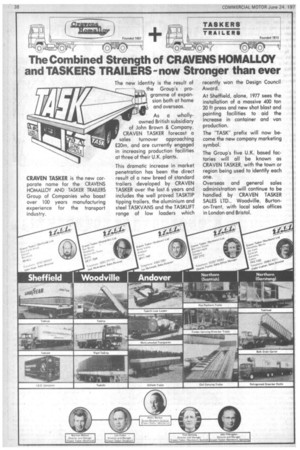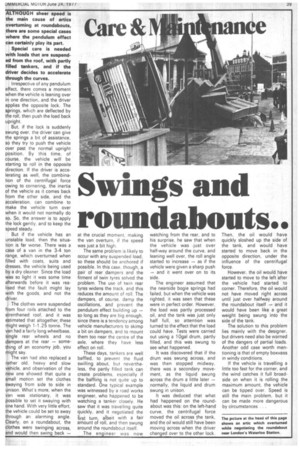The Combined Strength of CRAVENS HOMALLOY and TASKERS TRAILERS-now Stronger than ever
Page 40

Page 41

If you've noticed an error in this article please click here to report it so we can fix it.
CRAVEN TASKER is the new corporate name for the CRAVENS 1-10MALLOY AND TASKER TRAILERS Group of Companies who boast over 100 years manufacturing experience for the transport industry. The new identity is the result of the Group's programme of expansion both at home and overseas.
As a whollyowned British subsidiary of John Brown & Company, CRAVEN TASKER forecast a sales turnover approaching £20m, and are currently engaged in increasing production facilities at three of their U.K. plants.
This dramatic increase in market penetration has been the direct result of a new breed of standard trailers developed by CRAVEN TASKER over the last 6 years and includes the well proved TASKTIP tipping trailers, the aluminium and steel TASKVANS and the TASKLIFT range of low loaders which recently won the Design Council Award.
At Sheffield, alone, 1977 sees the installation of a massive 400 ton 20 ft press and new shot blast and painting facilities to aid the increase in container and van production.
The "TASK" prefix will now become the new company marketing symbol.
The Group's five U.K. based factories will all be known as CRAVEN TASKER, with the town or region being used to identify each one.
Overseas and general sales administration will continue to be handled by CRAVEN TASKER SALES LTD., Woodville, Burtonon-Trent, with local sales offices in London and Bristol.
ALTHOUGH sheer speed is the main cause of artics overturning at roundabouts, there are some special cases where the pendulum effect can certainly play its part.
Special care is needed with loads that are suspend ed from the roof, with partly filled tankers, and if the driver decides to accelerate through the curves.
Irrespective of any pendulum effect, there comes a moment when the vehicle is leaning over in one direction,. and the driver applies the opposite lock. The springs, which are deflected by the roll, then push the load back upright.
But, if the lock is suddenly swung over, the driver can give the springs a bit of assistance, so they try to push the vehicle over past the normal upright position. By this time, of course, the vehicle will be starting to roll in the opposite direction. If the driver is acce lerating as well, the combination of the centrifugal force owing to cornering, the inertia of the vehicle as it comes back from the other side, and the acceleration, can combine to make the vehicle turn over when it would not normally do so. So, the answer is to apply the lock gently, and to keep the speed steady.
But if the vehicle has an unstable load, then the situa tion is far worse. There was a case of a van in the 3-4 ton range, which overturned when filled with coats, suits and dresses, the vehicle being used by a dry cleaner. Since the load was so light it was some time afterwards before it was realised that the fault might lay with the goods, and not the driver.
The clothes were suspended from four rails attached to the strenthened roof, and it was estimated that altogether, these might weigh 1-1.25 tonne. The van had a fairly long wheelbase, single rear wheels and no dampers at the rear — something of an economy job, you might say.
The van had also replaced a rather old, heavy and slow vehicle, and observation of the new one showed that quite a small motion set the clothes swaying from side to side in Unison. What's more, when the van was stationary, it was possible to set it swaying with one hand. With very little effort, the vehicle could be set to sway through an alarming angle. Clearly, on a roundabout, the clothes were swinging across, and would then swing back -




































































































